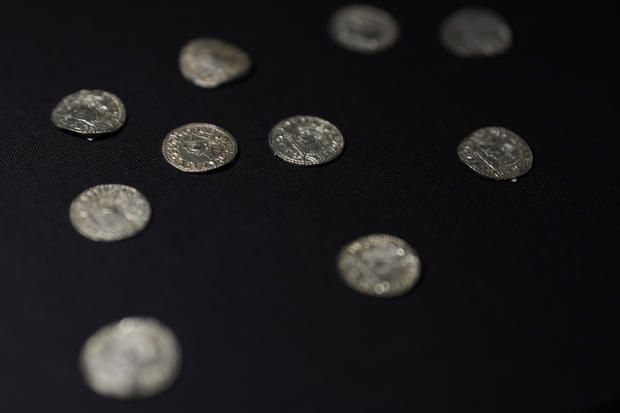Adam Staples could hardly believe his ears when his metal detector started to beep. One beep turned into a chorus of beeps—each signaling the discovery of something extraordinary.
An Edward the Confessor Pyramid coin (1065-6), part of the Chew Valley Hoard of 2,584 coins, buried in the turmoil following the Norman Invasion of Britain in 1066, is seen on display at the British Museum in London, Oct. 22, 2024. AP PHOTO/ALASTAIR GRANT
In a farmer's field in southwest England, Staples and six friends uncovered a hoard of over 2,500 silver coins that had remained buried for nearly 1,000 years. Valued at a staggering $5.6 million (4.3 million British pounds), this collection is now destined for a museum, where it will offer fresh insights into the chaotic years following the Norman Conquest of England.
"The first coin we found was from William the Conqueror—worth about £1,000 to £1,500," Staples shared at the British Museum on Tuesday. "We thought there might be five, maybe ten coins. But the find just kept growing." By the end, they had unearthed the largest treasure Staples had ever encountered in his 30 years as an amateur detectorist.
The hoard, discovered in 2019 and now owned by the South West Heritage Trust, consists of 2,584 silver pennies minted between 1066 and 1068. Some bear the image of King William I, while others depict his predecessor, the Anglo-Saxon king Harold II, who was defeated at the Battle of Hastings.
Michael Lewis, head of the Portable Antiquities Scheme, described the find as "one of the most spectacular discoveries in recent years." He noted that the true significance of the hoard is still unfolding, as it sheds light on the famed year of 1066—when William, Duke of Normandy, toppled Harold to claim the English throne.
"Most of us learn about the Norman Conquest in school as a clash between 'good' Saxons and 'bad' Normans," Lewis remarked. "But it's much more nuanced than that. The hoard tells a different story—one that blurs the lines between victor and vanquished."
While the Norman Conquest marked a monumental shift in English history, the coins tell a subtler tale. Whether minted before or after the conquest, the coins share a similar design: a monarch’s profile on one side and, for William’s coins, an intricate cross on the reverse. Harold’s coins, ironically, feature the word "pax"—meaning peace.
Amal Khreisheh, an archaeologist with the South West Heritage Trust, believes the coins were buried as rebellions flared up against William’s rule. "In 1068, the people of Exeter revolted, and Harold’s sons, who had fled to Ireland, began launching attacks along the River Avon," she explained. "It’s likely the hoard was hidden to keep it safe during these uprisings."
The hoard, now known as the Chew Valley Hoard, has been purchased for the nation with funds from Britain’s national lottery. After its debut at the British Museum, it will be displayed in museums across the U.K. before finding a permanent home at the Museum of Somerset in Taunton, 130 miles from London.
The coins’ journey from discovery to museum display has been a lengthy process due to Britain's Treasure Act. Under the law, anyone who finds valuable artifacts must report them to a coroner. Once declared treasure, the find becomes property of the state, and museums can then acquire it through funding bids.
An expert panel determined the hoard’s value at £4.3 million, with half the amount split between the finders and the landowner. Staples revealed that his share was in the "hundreds of thousands" and allowed him to buy a house. Despite his windfall, he has no plans to give up metal detecting, calling it his lifelong passion.








